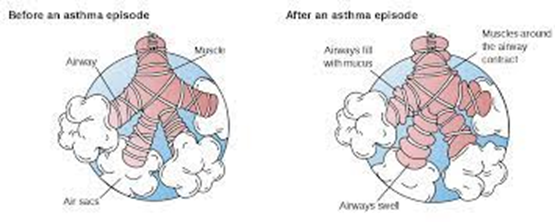A nurse is caring for a client who has multiple sclerosis and is experiencing progressive multifocal leukoencephalopathy (PML). Which of the following medications should the nurse recognize is associated with the development of PML?
Pregabalin
Natalizumab
Furosemide
Metoprolol
The Correct Answer is B
Choice A Reason:
Pregabalin is incorrect. Pregabalin is a medication used to treat neuropathic pain, seizures, and generalized anxiety disorder. It is not associated with an increased risk of PML.
Choice B Reason:
Natalizumab is correct.: Natalizumab is a monoclonal antibody used to treat relapsing forms of MS. It is associated with an increased risk of developing PML, particularly in individuals who are JC virus antibody positive. Regular monitoring of JC virus antibody status and clinical vigilance is required when using natalizumab to reduce the risk of PML.
Choice C Reason:
Furosemide: Furosemide is a loop diuretic used to treat edema and hypertension. It is not associated with an increased risk of PML.
Choice D Reason:
Metoprolol is incorrect .Metoprolol is a beta-blocker used to treat hypertension, angina, and heart failure. It is not associated with an increased risk of PML.
Nursing Test Bank
Naxlex Comprehensive Predictor Exams
Related Questions
Correct Answer is D
Explanation
Choice A Reason:
Bronchopneumonia is incorrect. Bronchopneumonia is characterized by patchy areas of consolidation involving multiple lobules scattered throughout the lungs. It typically results from bronchial obstruction and aspiration of infected material into the smaller airways and alveoli.
Choice B Reason:
Severe pneumonia is incorrect. "Severe pneumonia" is a broad term that can refer to pneumonia with various degrees of severity. It does not specifically describe the pattern of consolidation involving the entire lobe of the lung.
Choice C Reason:
Empyema is incorrect. Empyema refers to the accumulation of pus in the pleural cavity, often as a complication of pneumonia. It does not describe the pattern of consolidation within the lung tissue.
Choice D Reason:
Lobar pneumonia is correct. Lobar pneumonia is characterized by consolidation involving an entire lobe or lobes of the lung. It typically results from infection by a single pathogen, such as Streptococcus pneumoniae, which leads to inflammation and consolidation of an entire lobe of the lung.
Correct Answer is C
Explanation
Choice A Reason:
Decreased mucus production contributes to airway constriction: This statement is incorrect. Bronchospasm does not decrease mucus production; instead, it primarily affects the smooth muscles surrounding the bronchioles, leading to their constriction and narrowing of the airways. Increased mucus production, often accompanied by inflammation, can contribute to airway obstruction in conditions like asthma.
Choice B Reason:
Inflammation is reduced due to airway diameter: This statement is incorrect. Bronchospasm typically occurs in the setting of inflammation in conditions such as asthma. Constriction of the airways during bronchospasm exacerbates the inflammation and can further narrow the airways, leading to symptoms such as wheezing and dyspnea.
Choice C Reason:
Bronchospasm occurs when there is inflammation, edema, and excess mucus: This statement is partially correct. Bronchospasm often occurs in the presence of inflammation, edema, and excess mucus production, as seen in conditions like asthma. These factors contribute to airway hyperresponsiveness, leading to bronchospasm and airway narrowing.
Choice D Reason:
Airway obstruction occurs due to thinning mucus: This statement is incorrect. Airway obstruction in conditions like asthma is primarily due to bronchospasm, inflammation, and excessive mucus production, rather than thinning mucus. Thinning of mucus would not typically contribute to airway obstruction.

Whether you are a student looking to ace your exams or a practicing nurse seeking to enhance your expertise , our nursing education contents will empower you with the confidence and competence to make a difference in the lives of patients and become a respected leader in the healthcare field.
Visit Naxlex, invest in your future and unlock endless possibilities with our unparalleled nursing education contents today
Report Wrong Answer on the Current Question
Do you disagree with the answer? If yes, what is your expected answer? Explain.
Kindly be descriptive with the issue you are facing.
